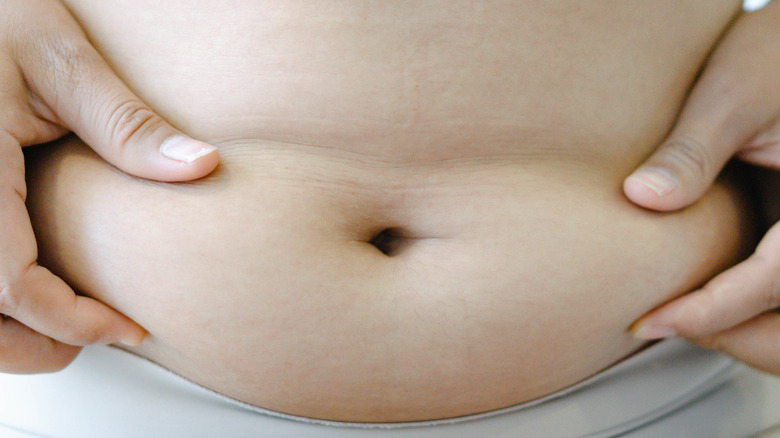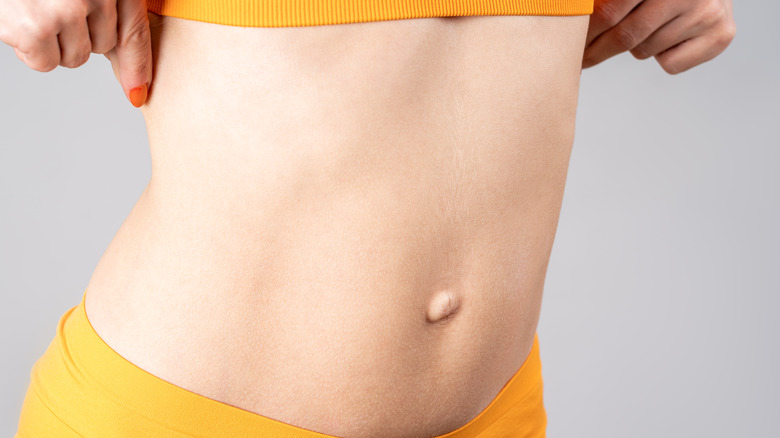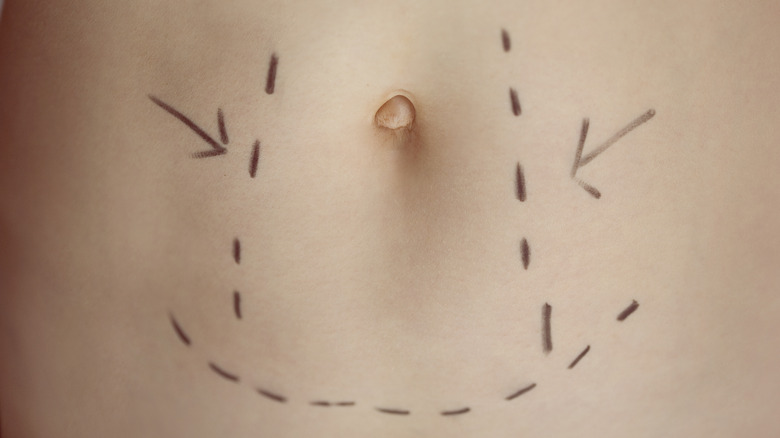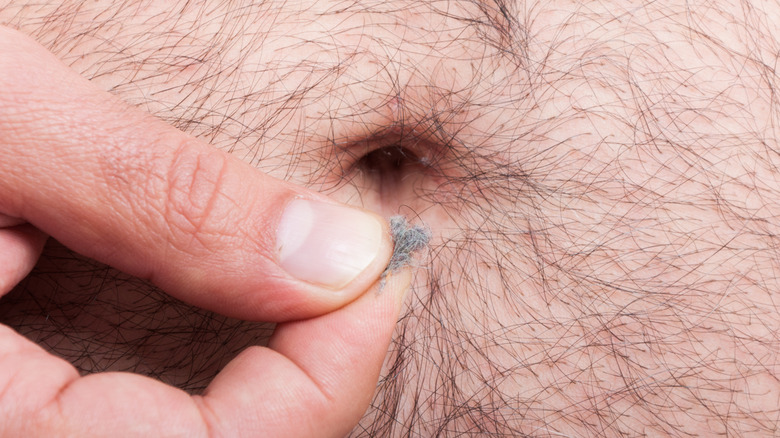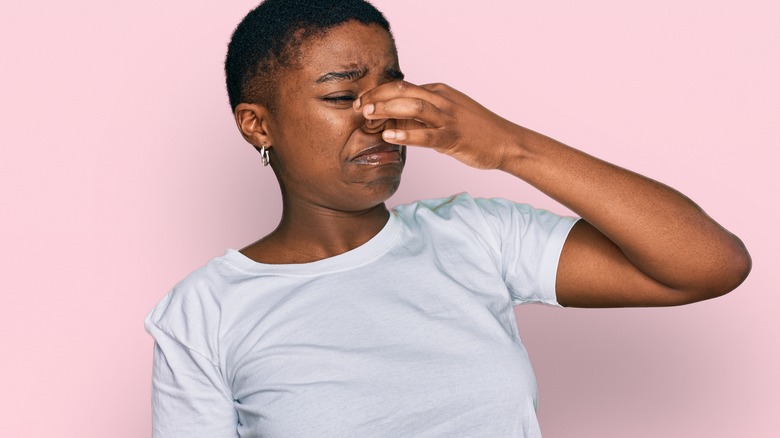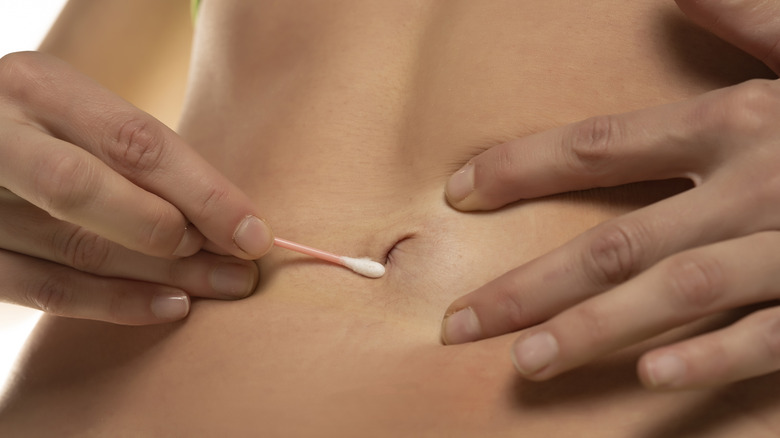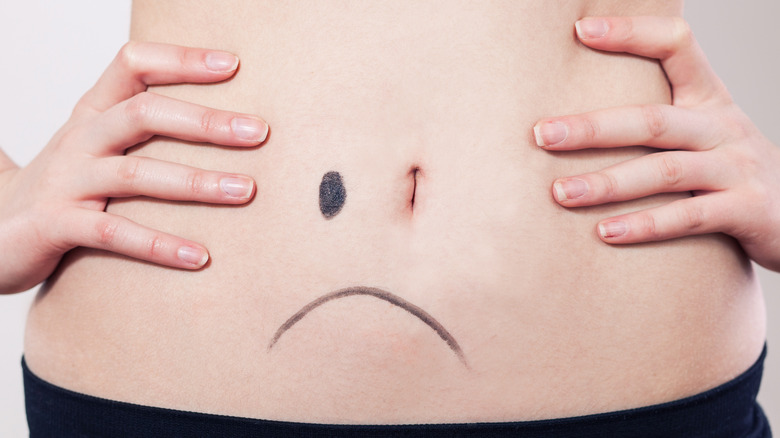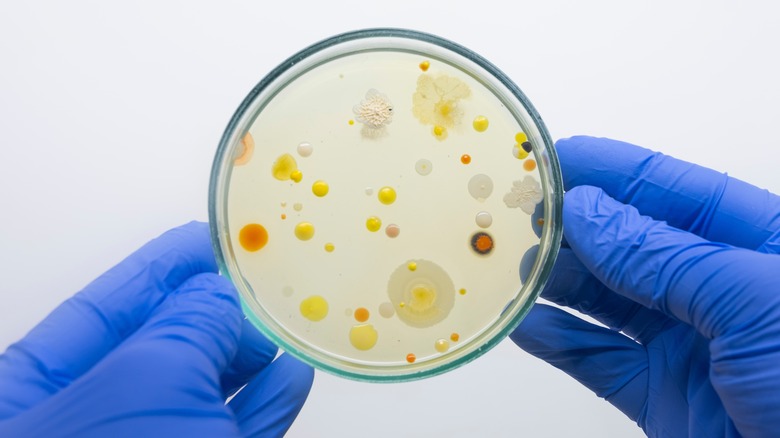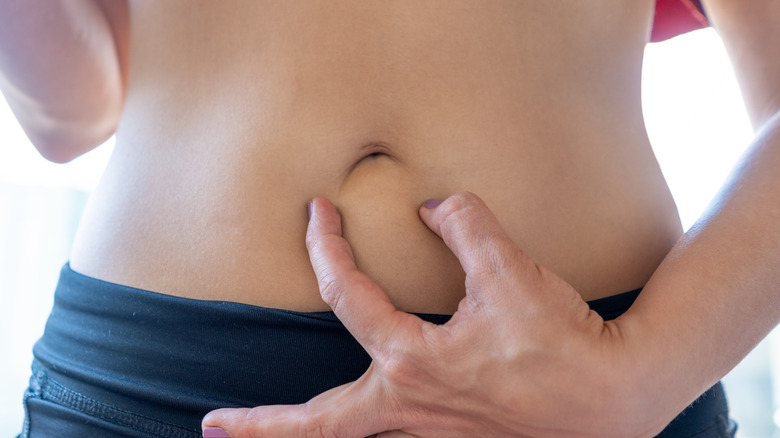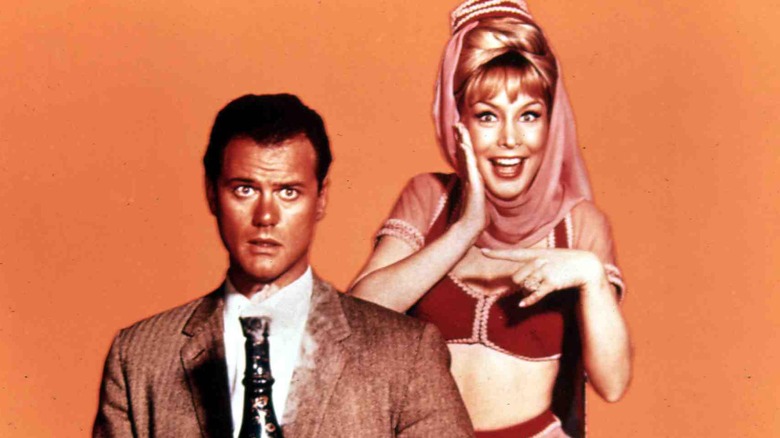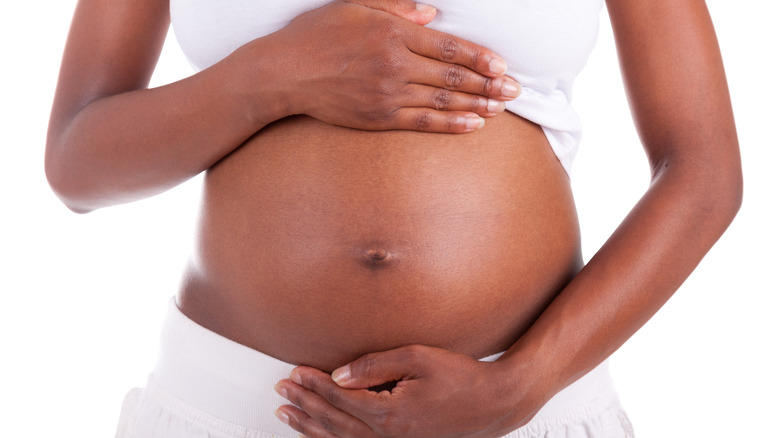The Most Common Questions About Belly Buttons Answered
The human body is complex and wondrous, like a league of machines churning away to help us function and live. The belly button, however, is one anatomical feature that tends to be overlooked. Unlike more useful body parts, the belly button just sits there in the center of your tummy, practically purposeless. But before you dismiss that tiny crater in your belly, remember that your navel used to have a very important purpose. The belly button is actually a remnant of the umbilical cord — an organ that exchanges blood between the carrier and the fetus during gestation. The cord connects to the placenta, which filters and re-oxygenates blood. Once a baby is born, the umbilical cord is snipped and clamped, and the belly button forms in its place (via CNN). Technically, your belly button is a scar from your umbilical cord (per Healthline).
Biology isn't the only impressive thing about belly buttons. They've also had quite the cultural transformation, from being censored on television to becoming the epicenter of a liberating style movement. Belly buttons are also the subject of superstitions and folklore. In Japan, for example, there is a deity called Raijin who likes to steal the belly buttons of children during thunderstorms (via Live Japan). And then there's Omphalomancy, the occult practice of gazing into the belly button to see the future. For all of these reasons and more, the navel is quite intriguing.
Why does every belly button look different?
Now that we've got you thinking about belly buttons, you might be wondering if there's anything remarkable about your own navel. There is no such thing as a "normal" belly button. However, a common type of belly button does indeed exist. For general purposes, navels are filed into two categories. There are innies, which dip inwards like a pit. Then you've got outies, where a bulb of skin pokes out of the belly button. According to BayCare, only 10% of the population is blessed with a protruding outie. Additionally, belly buttons can appear horizontal, vertical, hollow, round, or bulb-shaped with a hood on top. For the most part, your belly button shape is entirely random and it's unrelated to how your umbilical cord was cut (via Winston Salem Dermatology).
For totally inexplicable reasons, researchers in Singapore set out to find the "perfect" belly button in 2014. Using a digital tool to analyze photos of 37 different Playboy models, the scientists decided that the most attractive belly button type is small and vertically positioned (via Today). To that, we say, "Hooray for science ...?" While these claims are completely subjective since all belly buttons are beautiful, the hypothesis does prove that some of us are very eager to unravel the mystery behind the navel.
Can I change the appearance of my belly button?
Most people strive to feel powerful and confident in their own skin. For some of us, that pursuit includes all of our skin, right down to the navel. That said, it's no surprise that you can get surgery to change the appearance of your belly button. Umbilicoplasty is more common than you might think, and according to Newsweek, its popularity is on the rise.
There's no shame in cosmetic surgery. Everyone deserves to feel beautiful, no matter what that means for them. However, if you think that umbilicoplasty is just for prima-donna types who compulsively nip and tuck every inch of their body, then you'd be wrong. There are actually plenty of reasons why folks wish to reconstruct the appearance of their belly buttons. For example, pregnancy, weight loss, and piercing scars are common motives for people to opt for a surgical belly button glow-up (via Healthline).
What's the deal with belly button lint?
If you've ever lifted up your shirt to find a furry invader inside your belly button, rest assured that you are not alone. Belly button lint, also known as navel fluff, is a completely normal occurrence that is caused by our clothing. Hairy bellies attract the most fluff because body hairs pick up little clothing fibers, which are then gobbled up by the navel (via BBC). In a way, your belly button is a convenient stash for wandering fuzz. And if you thought that belly button lint collectors only existed in campy movies, guess again. According to Metro, an Australian Man named Graham Barker holds the Guinness World Record for the largest belly button lint collection. Barker has reportedly been stockpiling his navel lint since 1984.
New clothes tend to shed the most fibers, so you might notice a bit of a lint surge after wearing that spiffy new shirt (via Time magazine). Additionally, your navel fluff can take on the color of your clothing. The next time you wear denim jeans, don't be surprised if a blue fuzz ball appears in your belly button. Although it can be annoying or even gross to deal with, belly button lint is a natural part of life.
Is it normal for belly buttons to be smelly?
In general, yes. Your belly button swallows up sweat, dead skin, dirt, and bacteria, which can definitely be the ingredients for a smelly cocktail (via Medical News Today). If you're very active — or if you skip a few navel cleanings — then you might be setting yourself up for a stinkier-than-normal belly button. While a very slight odor can be considered normal, a strong odor is a cause for concern. Additionally, if you've got any fluid coming out of your belly button, it may be a sign of infection. The most common culprit for abnormal navel odor and discharge is candida, a type of yeast that causes infection when it grows in excess (via Parade).
More rarely, belly button odor can be caused by umbilical stones. Medically known as omphaloliths, navel stones are caused by a build-up of oil and dead skin cells that harden into a stone-like consistency. Omphaloliths are associated with a foul stench, as well as pain, redness, and infection (via Healthline). Those with deeper belly buttons are more likely to suffer from navel stones. These nasty little nuggets can be removed, but it's best to prevent them altogether. Fortunately, regular cleanings will help banish dirt and unpleasant odors from your belly button.
How should I clean my belly button?
Undoubtedly, bathing is a necessity — but lathering up regularly might not be enough to keep your navel optimally clean. Your navel should have its own hygiene routine to prevent a buildup of gunk, and how you clean your belly button depends on whether you have an innie or an outie (via Women's Health).
If you have an innie, you'll want to use a cotton swab soaked in rubbing alcohol. After gently swishing the swab around the inside of your navel, repeat the process with a new cotton swab that has been dipped in water (via Healthline). If your skin is prone to dryness, nix the rubbing alcohol and try soapy water instead. Another pro tip for the innie gang: Avoid using lotion directly inside of your belly button, as this can encourage bacterial growth. For those with an outie, it's best to use a soaped-up washcloth to gently clean the area.
Does everyone appreciate belly buttons?
While many of us might feel indifferent toward that tiny trench on our tummy, others regard the belly button as a thing of beauty. Furthermore, the navel is an erogenous zone, meaning that some folks associate it with sexual pleasure. However, belly button adoration is not universal. In fact, some people live with an extreme fear of belly buttons, known as omphalophobia. This occurs in people who feel panic and terror when they see a belly button. The condition often leads to an avoidance of places, like pools and beaches, where navels are more likely to be on display (via Healthline).
On the other end of the spectrum, some communities revere the belly button. Shibukawa in Japan, for instance, has an entire festival dedicated to this cavernous little body part. Much like our own centrally located navels, Shibukawa lies in the middle of Japan — hence why it has been dubbed "Japan's belly button" (via Reuters). At the Shibukawa belly button festival, participants paint their bellies to look like whimsical faces. The event is packed with food, dancing, and a dazzling parade. You can even touch the belly button Jizo — a special historic rock that is said to make wishes come true.
Does everybody have a belly button?
It seems surreal, but there are people in this world who don't have a navel. Since the belly button isn't medically necessary for survival, a person can get by just fine without one. Most of the time, a non-existent belly button is the result of certain medical conditions or surgeries (via Healthline).
Having a perfectly smooth tummy might invite some unwelcome stares, but plenty of navel-less icons are proud of their unique bodies. For example, Czech supermodel Karolína Kurková has cat-walked her way to the top of the fashion industry, no belly button necessary. Unfortunately, toxic beauty culture spares no one, not even Kurková. Magazines have been known to retouch images of the model's body by tacking on a fake navel (via HuffPost).
In January 2022, a TikToker went viral with her no-navel midriff. The video racked up more than 22 million views. In a follow-up video, the creator explained, "I was born with what's called a giant omphalocele, which is like, my organs were in a sac outside of my body." She revealed that it took multiple surgeries to correct the birth defect, which eventually erased her belly button. According to the Children's Hospital of Philadelphia, omphalocele happens to one in 4,000 to 7,000 babies.
What's going on inside of my belly button?
The answer: A lot more than you'd expect! Like many body parts, belly button skin is home to a mélange of microorganisms including yeast, bacteria, and fungi (via NBC News). How many different microbes occupy that little abyss in our tummies? That's the question that inspired the Belly Button Biodiversity project — a 2011 study where researchers swabbed and tested the navels of 60 individuals. Rob Dunn and a team of ecologists recorded 2,368 different species of bacteria in the belly buttons that were tested. The scientists found that belly buttons are remarkably diverse, with each navel containing its own distinct bacterial community. Surprisingly, one participant's navel harbored a species of bacteria that typically lives in thermal vents and on ice caps (via National Geographic). Altogether, the Belly Button Biodiversity Project unearthed 1,458 potentially new bacteria species.
Haters will say that it's pointless to study belly button bacteria, but Dunn maintains that finding previously undiscovered microbes is a major win for science. "We're finding not only whole new species in belly buttons but whole new lineages," the researcher said (via NPR).
Why do I get a strange feeling from poking my belly button?
Belly button curiosity is as natural as the little orifice on your abdomen. If you've ever felt the urge to plunge a finger into your belly button — just to know what it feels like — then you're in good company. Most of us have given our own belly buttons a good prodding at some point in life. For the majority of people, a poke to the belly button generates a pretty weird feeling, and there's a scientific reason for that.
By poking your navel, you're able to access some of the deeper fibers that transfer nerve signals to your spinal cord. Your spinal cord can misinterpret the message, prompting you to feel the urge to pee, according to Dr. Christopher Hollingsworth (via LADbible). "The internal lining of the abdominal cavity at your umbilicus (belly button) is called your parietal peritoneum. This structure is exquisitely sensitive and its sensory nerve fibres relay input back to the spinal cord at the same level as the nerves that relay sensation from your bladder and urethra," said Hollingsworth.
There are other sources of belly button discomfort that don't involve jabbing your navel with a finger. According to Women's Health, belly button pain can indicate certain health conditions, including Crohn's disease, hernia, indigestion, appendicitis, and gallstones.
Are belly buttons controversial?
Wherever there are powerful women, you're sure to find some bizarre, patriarchal rules designed to control them. Such was the case for several decades in American television, where women's navels were the subject of strict censorship policies. The 1960s and '70s were especially rife with belly button controversy. At the center was the star of "I Dream of Jeannie," Barbara Eden. In a 2015 interview, Eden recalled how her character's midriff-baring costume brought the censorship debate to a fever pitch (via Today). "[The producer] said he had never seen so many suits sitting around a table in his life discussing someone's anatomy. ... They became very strict about the navel," Eden said.
The first female navel on an American TV screen belonged to actress Yvette Mimieux in 1964 (via MeTV). Mimieux's midriff walked so that others could run. In the 1960s, "Star Trek" famously averted censors by showing the navel of the character Uhura in all of its glory (via CBR).
In the late 1990s and early 2000s, the belly button was once again the center of attention — and this time, it was more liberated than ever. Fashion icons like Aaliyah, Destiny's Child, and Britney Spears helped usher in the era of Y2K fashion, which featured belly shirts and unapologetically low waistlines. Blingy navel piercings also dominated the fashion scene, which made the belly button an even bigger focal point. Thanks to the current revival of Y2K style, the navel is back and better than ever.
Will pregnancy change my belly button?
Pregnancy changes the body in remarkable ways, and it's quite common for the belly button to be included in this metamorphosis. Throughout pregnancy, the carrier's abdomen continually expands to accommodate that growing bun in the oven. In many cases, the pressure of a growing uterus forces the belly button to poke out, temporarily turning an innie into an outie (via Cleveland Clinic). Although it can be challenging to deal with pregnancy symptoms, that adorable pregnancy belly button is often a huge, bright spot. Whether a person loves or hates the changes they see in their pregnant body, growing a baby is a remarkable feat. So for that reason, we tip our hats to the pregnancy outies of the world.
Not everyone will be blessed with a puffed-up outie during pregnancy. Sometimes, the belly button becomes flat. In other instances, it doesn't change at all. Fortunately, all of these scenarios are considered completely normal. Pregnancy can also cause the belly button to become more itchy or painful than normal (via Verywell Family). In most cases, the change is only temporary and the resilient navel bounces back after pregnancy.
